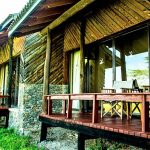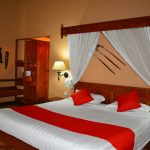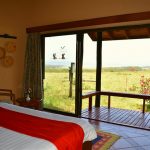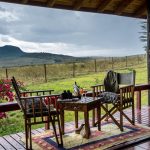You are met on arrival at the Jomo Kenyatta International Airport and transferred to your hotel. Overnight stay on Bed and Breakfast basis at Jacaranda Hotel or similar.
Depart after breakfast and drive to Nanyuki arriving at your lodge in time for lunch. Naro Moru River Lodge is located along the banks of the Naro Moru River. The extensive grounds include stretches of natural woodland as well as scrub which is home to the Lesser Kestrel and the Purple-throated Cuckoo-shrike. When weather is good, large numbers of raptors can be seen. Watch out for Bronze-naped and green pigeons, grey-headed Negrofinch, sandpipers, waders, Montane Oriole, Tacazze Sunbird, Montane White-eye and Black and White Mannikin. Also to be spotted are Green Ibis, Lesser Spotted Eagle, Harrier Hawk, Rufous Sparrow hawk, Ayre’s Hawk Eagle, Black stork, Red Fronted Parrots, Green Ibis Common snipe, Mountain Buzzard, Abbots Starling, Sharpe’s Starling and Thick-billed seedeater among others. Dinner and overnight stay at Naro Moru River Lodge.
Day spent looking out for birds in the woods. All meals and overnight stay at Noru Moru River Lodge.
Depart after breakfast and drive to Lake Nakuru National Park arriving in time for lunch at the lodge. This park known as the bird watchers’ paradise is famous for flamingos. It is also an important habitat for more than 450 species of birds, including multiple endangered birds such as the martial eagle and the Madagascar pond-heron. Also to be seen are African fish Eagle, Tawny Eagle, Green Wood Hoopoes, Cliff Chat, Great White and Pink Backed Pelicans, White winged Black Tern, Hilderbrants Francolin, Steppe eagle, Grey crested Helmet Shrike, Red-capped lark, Spotted Crake plus other intra- African Migrants. The grater and lesser flamingos both shade the lake pink. Dinner and overnight at Lake Nakuru Lodge.
Day spent in the park. All meals and overnight stay at Lake Nakuru Lodge.
Breakfast at the lodge then depart for Lake Baringo. This is the most northerly of the Rift Valley Lakes. The lake is fed by two rivers, El Molo and Ol Arabel and has no obvious outlet, despite this, it is one of the only two freshwater lakes (it is in fact slightly saline). The climate in the region is generally hot and dry and away from the lake shore the surrounding countryside appears quite barren. However the imposing cliffs house a variety of bird life. Some of the birds to see include Vereaux’s Eagle, Heuglin’s or Three-banded courser, Lichtenstein’s Sand-grouse and the Spotted thick-knee. Pale and dark phase Gabar Goshawk, Paradise Flycatcher, African Fish Eagles, Marabou Storks, Shikra and White-faced Scops Owl, Brimstone Canary, Goliath Heron, Little Weaver and Jackson’s Hornbill, Cape Eagle Owl, Brown-Tailed Rock Chat, Nothern Red Bishop, Northern Masked Weaver and White Billed Buffalo Weaver, Olivaceous Warbler, Northern brownbul, Jackson’s golden backed weaver, Little weaver, Northern Shoveller, Verreauxs eagle owl, Bristle crowned starling, Senegal Thicknee, Pygmy falcon, Blue cheecked bee-eater are amongst the regular sightings. Some of the less common birds that can be seen here include; Hemprich’s Hornbill (along the cliffs), the African Darter and occasionally the African Skimmer. In total, more than 470 species have been recorded here. Dinner and overnight at Roberts Camp.
Day spent in Baringo. All meals and overnight stay at Roberts Camp.
Depart after breakfast and drive to Kakamega arriving in time for lunch at your lodge. Situated in Western Kenya, along the northeastern edge of the Lake Victoria basin at an altitude of 1,500-1,600 meters, the Kakamega Forest is a remnant of rainforest which once spanned the Equator from the West to East coasts of Africa. Gazetted as a Trust Forest in 1933 it covers an area of 240km². Since 1986 the Kenya Wildlife Service have managed a portion of the northern forest which is designated as a National Reserve and covers an area 36km². It is an important conservation area, famous for its birds and butterflies. The birdlife of Kakamega forest is a fascinating and unique combination of central African lowland species (which dominate the list) sitting alongside highland species. It is probable that at least 45 of the species on the Kenya list are to be found only in Kakamega forest. It is the last refuge in Kenya of the Grey Parrot which is present in very low numbers and is close to being extirpated (locally extinct). Two other species, Turner’s Eremomela and Chapin’s’ Flycatcher, are globally threatened and a further 15 species are regionally-threatened. Amongst the Kakamega specials are Ansorge’s Greenbul, the Blue-headed Bee-eater, the Red-chested Owlet, Shelley’s Greenbul, Grey-chested Illadopsis, Brown Illadopsis and the Green-throated Sunbird. Dinner and overnight stay at Rondo Retreat Lodge.
Day spent in Kakamega. All meals and overnights stay at Rondo Retreat Lodge.
Leave after breakfast and drive to Maasai Mara Game Reserve arriving in time for lunch at the lodge. The Maasai Mara Game Reserve is world famous for big game. Together with the adjoining Serengeti National Park in Tanzania, it is one of the few places in the world where it is still possible to see vast herds of grazing animals. Attracted by those huge herds are the predators; Lion, Leopard, Cheetah and more. However, a visit to the Mara isn’t only about seeing the “Big 5”, it’s also home to a wide variety of birds. Six out the seven species of the Kenyan vultures can be seen including, Egyptian vulture, Hooded vulture, Griffon vulture, Nubian vulture, White-backed vulture and White-headed vulture. But it isn’t only carrion eaters that can be found in this area, the birdlist totals over 450 species. These range from the large and highly conspicuous Common Ostrich, to the small (but still conspicuous) Cardinal Quelea. From the ever-present White-bellied Go-away-bird to its two uncommon relatives, the Bare-faced Go-away-bird and the Eastern Grey Plantain-eater. The Mara is also home to three relatively uncommon Woodpeckers (Golden-tailed, Little Spotted and Fine-banded). If you get really lucky then the Mara River provides an opportunity to spot the rare and elusive African Finfoot. The Mara is also one of the most likely spots for the Blue Quail, a rare intra African migrant. Dinner and overnight at Mara Serena Lodge.
All day spent in the Mara. You will change the lodge to Mara Sopa Lodge. Dinner and overnight stay at Mara Sopa Lodge.
Morning and afternoon game drives in the reserve with all meals and overnight at Mara Sopa Lodge.
Depart for Nairobi arriving in time to arrange for own lunch. Thereafter transfer to the airport for your onward international flight.
Please fill in the details below and our travel consultants will get back to you with the specified iteneray within 24 hrs.





